Convair B-36 long-range US strategic bomber (part of 2)
After the pickup, the RF-84F reconnaissance aircraft was located in a semi-submerged position under the fuselage of the B-36 aircraft.
Initially, it was supposed to hang at the ends of the wing of the B-36 two F-84E aircraft performing the role of escort fighters. As provided for the original project, the bomber takes off with the fighters; after the fighters are uncoupled, their attachment points to the bomber are dropped,
and the fighters, on completing the mission, land on a nearby airfield. After mature thinking, the Americans had serious doubts about the efficiency of such a combat complex under the active opposition of the enemy’s air defenses, and it was decided to limit the use of aircraft fleets only for reconnaissance purposes (a combination of strategic reconnaissance / tactical reconnaissance with enhanced survival). In flight tests, which took place from the middle of 1952 to the beginning of 1953, using modified RB-36F and RF-84F, RF-84F reconnaissance pickup was additionally implemented in the air after the completion of the mission (project Tom-Tom). The operation of establishing RF-84F contact with the wing assembly of the carrier turned out to be extremely dangerous, and during the flight of the aircraft “in conjunction” because of the comparatively low rigidity of the wing, there were oscillations of the reconnaissance aircraft in flight.
After one of the sorties caused a break in the wing mount as a result of the hesitation, the Air Force abandoned this method of mounting and opted for a tactical reconnaissance suspension in a semi-submerged position under the carrier's fuselage (i.e., as in the case of the XF-85). After working out this scheme in 1952-1953, the United States Air Force decided to introduce the concept of aircraft fleet in combat units and in 1955, after re-equipping the existing aircraft, they took into service seven carriers of GRB-36D-III and 23 outboard reconnaissance RF-84K. However, the operation of airborne interception, with which highly skilled test pilots coped quite successfully under experimental conditions, was not easy for combatant pilots in actual operation. On the very first day of training, three out of six RF-84K scouts were damaged while attempting to contact the carrier. Subsequent trainings did not lead to an improvement in the situation and, recognizing the concept of a “bundle” as dangerous, the military in February 1956 finally rejected it.
The B-36 was also proposed as a carrier of a supersonic bomber. However, the complexity of this task forced us to abandon such attempts in 1951 (see the section on the Convair B-58 aircraft). Nevertheless, the aircraft B-36 once had to play this role: for the air transportation of the glider B-58 bomber to the center of static strength testing. In 1952- 1953 one of the B-36H was modified and tested as a tanker with a hose-cone system. This idea also has not advanced further experiments.
A modified bomber, designated NB-36H, was used as a flying laboratory in another interesting project related to the research of an aircraft with a nuclear power plant (YASU). NB-36H has a new nose and is equipped with a nuclear reactor located in the rear fuselage and not connected with the engines of the aircraft. A powerful system of biological protection using a lead shield is provided, and the control of the reactor operation is provided by means of a TV set. Between September 17 1955 and March 28 1957, the NB-36H made 47 flights with a nuclear reactor on board. The possibility of creating an experimental X-36 aircraft with YSU based on B-6 was considered, but this idea was not implemented.
The NB-36H tests were carried out as part of large-scale nuclear weapons operations that began in the USA in 1951 under the ANP (Aircraft Nuclear Propulsion - aviation YaSU), curated by the Air Force and the United States Atomic Energy Commission. In 1954, the U.S. Air Force formulated the terms of reference for the atomic bomber WS-125A, and the next year it began competitive development by two industrial groups, each of which included aircraft and engine manufacturing companies: Conver / General Electric and Lockheed / Pratt-Whitney. General Electric led a nuclear installation of the so-called direct cycle, in which a nuclear reactor replaces the conventional combustion chamber of a turbojet engine, i.e. air from the compressor is heated by passing directly through the reactor. Such a scheme simplifies the design of the engine, but creates an increased radiation hazard to the environment and maintenance personnel, as the exhaust gases and engine components become radioactive. The leading role in these works was played by the Germans Bruno Brookman and Gerhard Neumann, who were formerly major specialists at the German company BMW. At first, the nuclear version of the J47 engine was investigated, but in the end the X-211 (J87) power plant was created as part of two new powerful turbofan engines, serviced by a single nuclear reactor. The total forced thrust was 243,5 kN (24830 kgf). Afterburners operated on conventional chemical fuel.
In contrast, the company Pratt-Whitney led work on the power plant of the indirect cycle. Initially, a turbojet engine with a water reactor and a steam turbine driving the fan with a diameter of 3,05 m was studied. The air from the fan was heated by passing through a steam turbine condenser, which in turn was transferred heat from a nuclear reactor. In 1953, a more promising power plant was studied with six J91 TRDs according to 111,2 kN (11340 kgf) and one molten-salt nuclear reactor, in which circulating fuel played the role of coolant.
At the end of the 1956, the US Air Force canceled the WS125A bomber program, finding its concept not viable, but continued to work on another atomic combat aircraft - the CAMAL (Continuous airborne Alert Missile-launching Aircraft) missile carrier, designed for continuous combat duty in the air and capable carry out air defense breakthrough at low altitude. For this project, Pratt-Whitney proposed an indirect cycle power plant with two to four solid-fuel nuclear reactors, two heat transfer circuits, and four modified J58 engines (the usual J58 installed on Lokhid SR-71). The CAMAL rocket carrier program was canceled in 1960, all of Conwair, which previously won the CAMAL project competition, was commissioned to build two experimental NX-2 subsonic aircraft - for flight tests of YASU, respectively, by General Electric and Pratt-Whitney. The flying laboratory of the NX-2 with the take-off weight of the 227 t should have flown into the air in 1965, but in 1961, its development was discontinued. At the end of the 1950, a version of the North American B-70 bomber with a nuclear power plant was also investigated.
It is interesting to note that in the USSR, the study of atomic aircrafts (cruise missiles and aircraft) began at the very beginning of the 1950s, almost simultaneously with the USA. Work on the creation of a flying atomic laboratory (LAL) “Lastochka” based on Tu-95 began in December 1955, and the NB-36H aircraft program was the impetus for this (the US Air Force publicly announced the flight tests of NB-36H in January). . and, possibly, that I. V. Kurchatov, on whose initiative the LAL studies were deployed, received out-of-date information about this through intelligence channels). “Swallow” took off for the first time in the summer of 1956 in the summer, but, like in the USA, did not continue. The problems of creating an atomic plane (excessive mass of the reactor and especially biological protection, radiation hazard, difficulties of dynamic regulation of the nuclear power station and, finally, the possibility of a nuclear catastrophe in the event of an accident or damage to the aircraft in combat conditions) proved to be insurmountable.
DESIGN
The B-36 is made according to the normal aerodynamic design and is an all-metal monoplane with a high-positioned small sweep wing, six PDs with pushing screws and (starting with the B-36D variant) four additional turbofan engines. Magnesium alloys are widely used in the construction (10% of the mass of the airframe).
The scheme with pushing screws was chosen mainly to take advantage of the laminar profile, which was very popular in those years, despite the major drawbacks of this arrangement. These include vibrations of the propellers and the rear edge of the wing, resulting from the operation of the propellers in the wing wake; a decrease in safety from flutter due to the displacement of engines to the tail of the wing; increased length (with large losses) of air intakes; insufficient cooling of engines when working on the ground due to the lack of jets from the screws. These problems were solved and, although the “trough of small resistance” on the characteristic of the laminar profile was not fully utilized in practice, the aerodynamically clean wing had very little frontal resistance. It is curious that the wing was made swept for reasons of centering the aircraft, but this led to a slight increase in the critical number M, an effect that was not “laid”, since the constructive effect of the sweep was not known to the designers of the Konver company at that time.
The wing of the caisson design with two beamed spars (on 12% and 43% chords) consists of a center section and detachable consoles. NACA 63 / 420 / 422 wing profile with relative thickness 22% at the root and NACA 65 / 318 / 517 with relative thickness 17% at the ends, elongation 11,1; sweep angle on the leading edge 15,1 °, on the back 3 °; length of the root chord 10,2 m, end 2,54 m; wing angle 3 °, transverse V angle equal to 2 °. Ailerons with trimmers and spring servo compensators are installed. Single-slit flaps (three sections on each console) with a total area of 48,2 and 2 occupy 42% wing span and are electrically driven.
A truss-beam fuselage of great elongation, with a circular cross-section, diameter 3,8 m. The crew cabins are located in the hermetic bow and tail parts (in front of and behind the bomb bay). On the first experienced XB-36, the front cockpit is inscribed in the fuselage contours, on the B-36A and in the subsequent versions, it is designed to improve visibility. The size and composition of the crew, as well as the layout of their workplaces changed several times, but before 1954, the typical crew of the bomber consisted of 15 people. and included up to three pilots, four navigator scorers, two flight engineers, two radio operators and four gunners. Two pilots are placed side by side on the upper deck, behind them (facing the flight) are two flight engineers, then a radio operator is on the middle deck, and navigators are scorers on the lower deck. In the rear cockpit fit two shooters and crew members from the replacement composition. The crew cabs communicate with each other by a hermetic magnesium alloy tunnel with a diameter of 0,64 m and a length of 25,9 m, passing along the left side of the board below the wing and equipped with a four-wheeled transport trolley. The total volume of hermetic compartments on the aircraft is 111,1 and 3.
Scouts have a more numerous crew reaching 22 people. In addition to the two pilots, the flight engineer and the shooters, the crew of the reconnaissance crew includes the navigator-aerial surveyor, the navigator-operator of the radar station, the meteorological observer, the three operators of the REP equipment and the technician photographer. In 1954 when modifying aircraft in configuration III, the bomber crew was reduced to 13 people, reconnaissance to 19 people. Entry into the aircraft through the hatch in the niche of the front landing gear with a retractable ladder.
Vertical (area 50,4 m2) and horizontal (span 22,4 m, area 90,9 m2) feathering caisson structure. The rudders of the direction and height of the one-spar construction with linen covering are supplied with spring trimmers and have axial compensation.
Tricycle landing gear with nose support, retractable. To facilitate the maintenance of the aircraft, it was originally intended to be equipped with one-wheel struts (with wheels with a diameter of 2,79 m), which were installed on both prototypes. However, a large one-wheel load limited the basing of the bomber to only a small number of airfields, which had sufficiently strong coverage. Therefore, in the middle of 1945, it was decided to switch to mass-produced racks with four-wheeled carts and a two-wheeled nose-rack, which made it possible to operate B-36 from all aerodromes suitable for lighter B-29. Multi-wheeled chassis have been refitted and experienced aircraft. The main supports are retracted in the wing towards the fuselage, the front - forward to the fuselage. Chassis track 14,0 m, base 18,0 m.
At the end of the 1950, on an experienced XB-36, flight tests of an experimental tracked chassis took place, the installation of which increased the aircraft’s mass on the 2,3 t and reduced the specific pressure on the runway from 1,1 MPa (11 kgf / cm2) (with a wheeled chassis) to 0,4 MPa ( 4 kgf / cm2). These studies developed research previously conducted on light and medium bombers and medium transport aircraft, but did not have any continuation.
POWER POINT
On all versions of the aircraft installed six PD Pratt-Whitney R-4360 (air cooling with a star-like arrangement of 28 cylinders) in various versions. The XB-36 and YB-36 prototypes, as well as the B-36A aircraft, use the R-4360-25 modification (6x2237 kW, 6x3042 hp). The B-36B and RB-36E are equipped with R-4360-41 with water injection (6x2610 kW, 6X3549 hp), B-36F and subsequent bomber versions - with an R-4360-53 modification with even higher power. The engines drive three-bladed pushing vane reversible propellers of variable pitch Curtiss Electric with a diameter of 5,8 m. Each engine is equipped with two turbochargers that run in parallel; one of them can be turned off in cruise mode. Air intakes of the superchargers are located in the toe of the wing.
Starting with the B-36D, turbojet engines were additionally installed on all versions of the aircraft. On the first B-36D aircraft (sometimes referred to as YB-36D, as an experimental machine) four Allan J35 TRDs were used, on all others - four General Electric J47-GE-19 TRDs. TRDs are installed in twin gondolas on external underwing pylons, i.e. similar to the scheme used previously on the Boeing B-47 and later on the B-52. B-36 gondolas are interchangeable with B-47 aircraft gondolas. The air intakes of J47 jet engines on the ground and in a cruise flight on a piston "thrust" were closed with wings. In the first case, the valves protected the engines from the ingress of foreign objects, in the second case the aerodynamic drag was significantly reduced.
On options for B-36H inclusive, fuel is placed in six wing tanks-compartments of the wing box with a total capacity of 79935 l. On the B36J, the capacity of the wing tanks was brought to 90775 l by installing two additional tanks for 5420 l in the end parts of the wing consoles. In addition, in the bomb bay it is possible to install two more (and according to some information, four) tanks with a capacity of 11355 l, which increases the total fuel supply to 113485 l (136200 l with four tanks in the bomb bay). There is no air refueling system. Oil tank capacity over 4540 l.
AIRCRAFT SYSTEMS
The control system of the aircraft is boosterless with cable wiring (total length 2400 m).
The aircraft is equipped with a powerful power supply system, which feeds around 300 electric motors. Almost all aircraft servomechanisms (with the exception of the landing gear drive and brakes) are driven from the on-board power network. The main one is the alternating current system (400 Hz, 208 / 115 V), direct current is used only in the weapon system. The energy sources are four 40 kW generators with a constant speed drive from the engines.
The hydraulic system with a working pressure 21 MPa (210 kgf / cm2) maintains the mechanisms for cleaning and releasing the chassis and activating the wheel brakes. The hydraulic system consists of two pumps with electric drive.
The thermal anti-icing system of the wing, tail assembly, propeller blades and engine air intakes is used.
TARGET EQUIPMENT
The navigation system of the B-36 aircraft includes a radar (AN / APQ-24 on B-36В) and an astronavigation system. At B-36H and J, an improved Blue Square bomber system is used, the main components of which were located in the hermetic compartment, which made it possible to eliminate system malfunctions during the flight. The radio navigation system LORAN, instrumental landing equipment, automatic radio compass, VOR receivers, interference transmitters, VHF radio stations are also used.
The standard RB-36D equipment kit consists of at least 14 cameras with a total weight of 1500 kg, including a giant camera with a focal length of 1220 mm. All this equipment is located in the front section of the weapons compartment. In the second section, up to 80 photographic bombs are installed, in the third compartment an additional fuel tank with a capacity of 11355 l is usually located, in the fourth compartment - electronic equipment. Options RB-36F and RB-36H carry a range of intelligence equipment with similar capabilities. The RB-36E is equipped with 23 cameras in the internal compartments, mainly of the type K-17C, K-22A, K-38 and K-40, EL tekzh6 photographic bombs. The installed equipment allows shooting day and night and evaluating the results of bombing.
ARMAMENT. Offensive weapon is located in the bomb bay divided into four sections and having a total volume of 348 m 3. In the first B-36, the bomb-compartments had sashes moving upward when opening, starting from B-36D, the sash had a hinged linkage.
Experienced aircraft and B-36A are not adapted for the delivery of nuclear weapons. Offensive weapons are installed from B-36B and include atomic bombs Mkl7, Mklll, MklV, Mk5, Mk6, B18, B24, B36 and B39. The greatest combat load of the aircraft is achieved by equipping it with two bombs Mk17 - the first American thermonuclear aviation devices, differing in huge mass (19050 kg) - but this imposes restrictions on the take-off weight of the aircraft.
The aircraft can carry conventional bombs in the following variants for loads: 12 bombs of 1814 caliber kg, 22 bombs Mk84 caliber 907 kg, 72 Mk83 - 454 kg, 129 Mk82 - 227 kg.
In 1952-1955 from the modified aircraft B-36H, which received the designation DB-36H, test launches of Bell GAM-63 “Raekl” cruise missiles (launch weight 8,3 t, launch range 120-160 km) were conducted. The tests were quite successful and at one time it was supposed to retool 11 B-36 for the Rasklov suspension, but after modifying only three Air Force planes they reoriented to using B-47 bombers as the carriers of this rocket, and in 1958 the development of GAM-63 was altogether discontinued.
The development of a defensive weapon system for B-36 was carried out by General Electric and was delayed: its full-scale tests began only in the summer of 1949, i.e. a year after the first serial modification of the bomber (B-36A) began to enter service. Thus, the prototypes and B-36A do not have defensive armament - it has been installed since variant B-36В. Moreover, the tests of the system were uneven and it was finalized only at the beginning of the 1950-s.
The defensive combat complex of bombers and scouts is identical and consists of 16 guns М24А1 (20 mm), having remote control and placed in pairs on eight turrets.
The bow and stern turrets are non-retractable, while the six others (located in pairs on top of the fuselage behind the cockpit, on top of the tail section of the fuselage in front of the keel and on the bottom of the tail section of the fuselage) are retractable and close in the retracted position with sliding doors to minimize the drag of the aircraft. Ammunition - 2x400 ammunition at the nose turret, 2x600 ammunition for the remaining turrets. The stern is equipped with a gun gun radar sight: AN / APG-3 on a B-36В aircraft, AN / APG-41A on a B-36Н.
From February to December 1954, in order to reduce the mass of the bombers and reconnaissance units that were in the ranks, the overwhelming part of the defensive armament was removed from them - only the stern unit with two guns was left (configuration - III).
In 1950, the possibility of arming the B-36 with air-to-air guided missiles instead of guns was studied. Missiles - Hughes MX-904 (GAR-1 "Falcon", weight 54 kg, launch range 8 km) from semi-active radar seeker - supposed to be placed in six launchers: one in the forward fuselage, two - from above, two - on the sides and one - in the tail section. Each PU has two guides for SD. However, by the beginning of the mass production of GAR-1 rockets in 1954. the fate of the B-36 has already been decided and no attempts to install the missiles have been made.
CHARACTERISTICS OF B-36J
DIMENSIONS. Wingspan 70,10 m; length of the aircraft 49,40 m; 14,26 aircraft height m; Wing area 443,33 and 2.
ENGINES. PD Pratt-Whitney R-4360-53 (6x2835 kW, 6x3855 hp with water injection) plus General Electric Turbojet J47-GE-19 (4X23,1 kN, 4X2360 kgf).
MASS AND LOADS, kg: maximum take-off weight of 185970 (for B36J-III - the same); combat weight 120700; empty 77580 aircraft mass (B-36J-III - 75370); actual maximum combat load: with take-off mass up to maximum (185970 kg) - around 32200 (72 conventional bombs МК83), limited to 162160 kg take-off weight - 38100 (two nuclear bombs МК17 by 19050 kg); typical combat load 4540; full fuel supply 113485 l (with two tanks in the bomb bay)
FLIGHT DATA. Maximum speed at the height of 11100 m - 662 km / h; the maximum typical speed at the height of 7620 m - 630 km / h; cruising speed 367 km / h; rate of climb at ground: with a maximum mass and normal mode of 3,7 engines, m / s, with a combat weight and maximum mode of 9,8 engines, m / s; takeoff distance (obstacle height 15 m) 2080 m; practical ceiling 12160 m; combat flight altitude 8350 m; combat radius with a load of 4,5 T - 5495 km (B-36J-III - 6420 km).
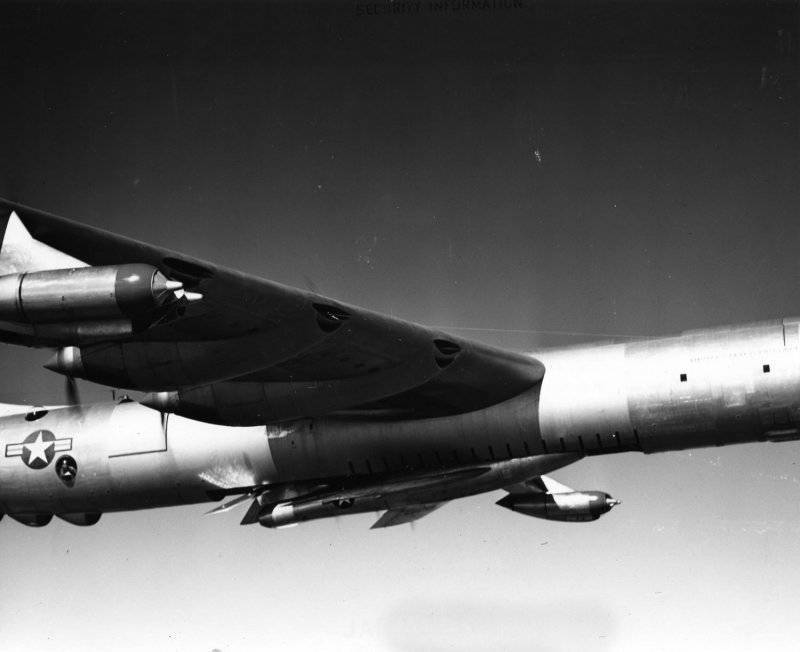
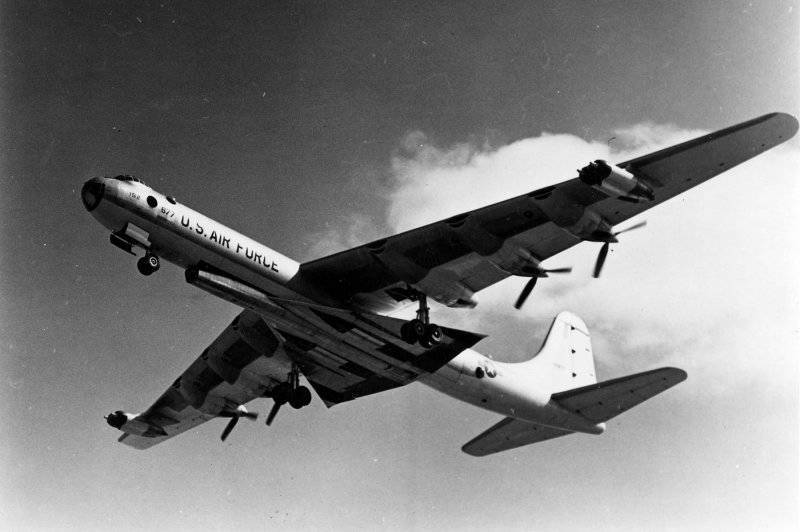
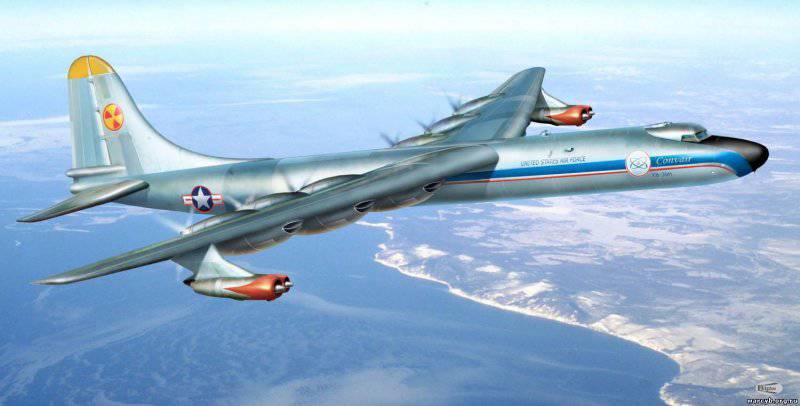
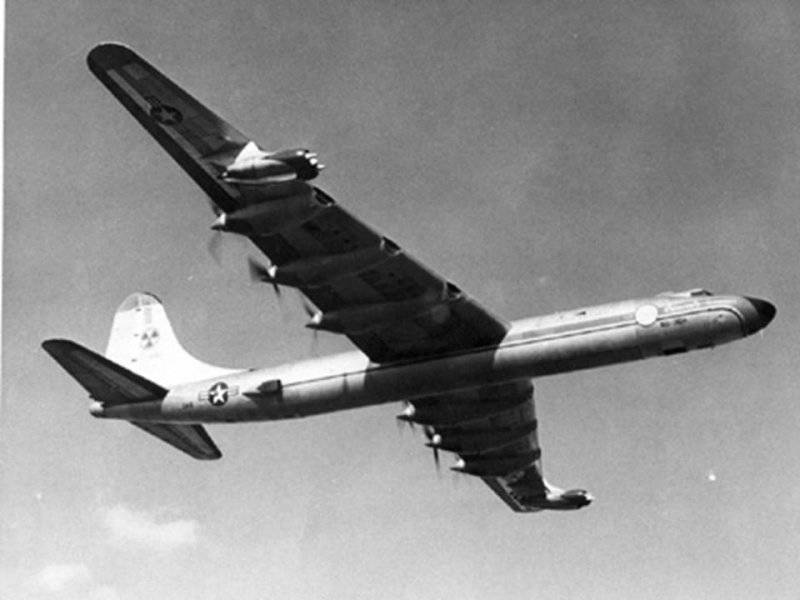
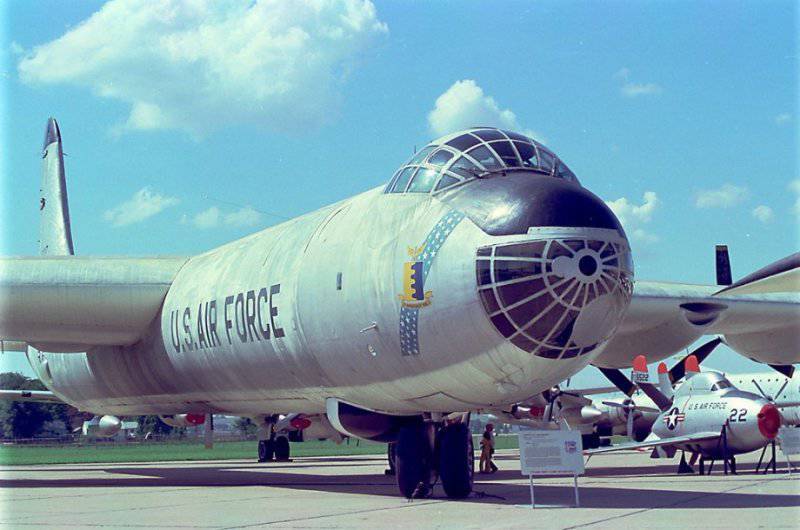
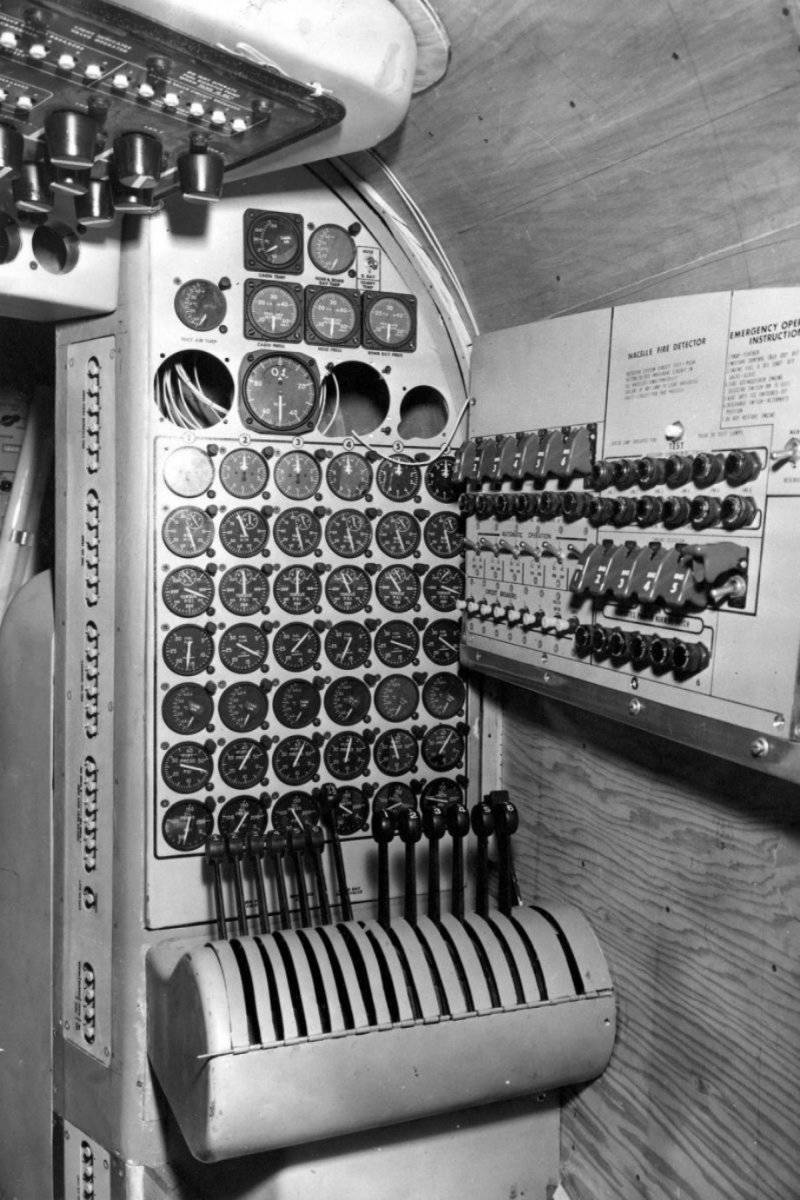
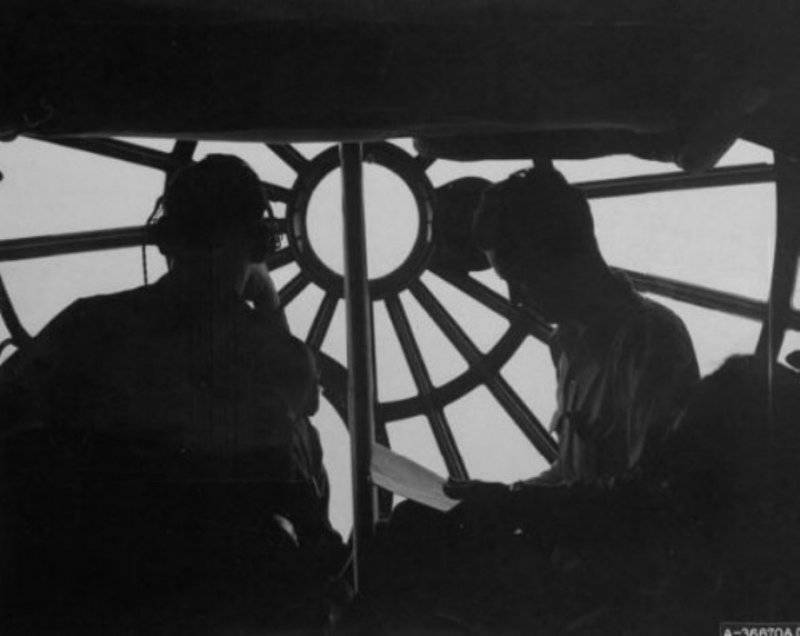
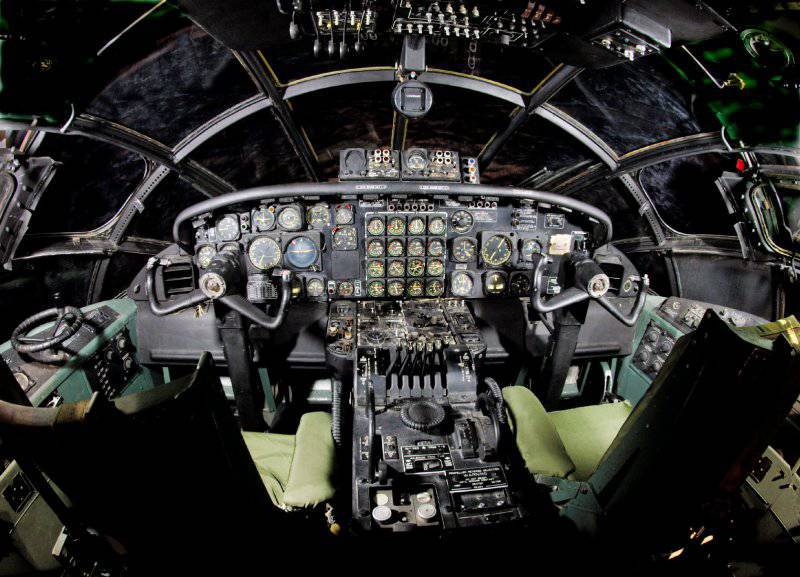
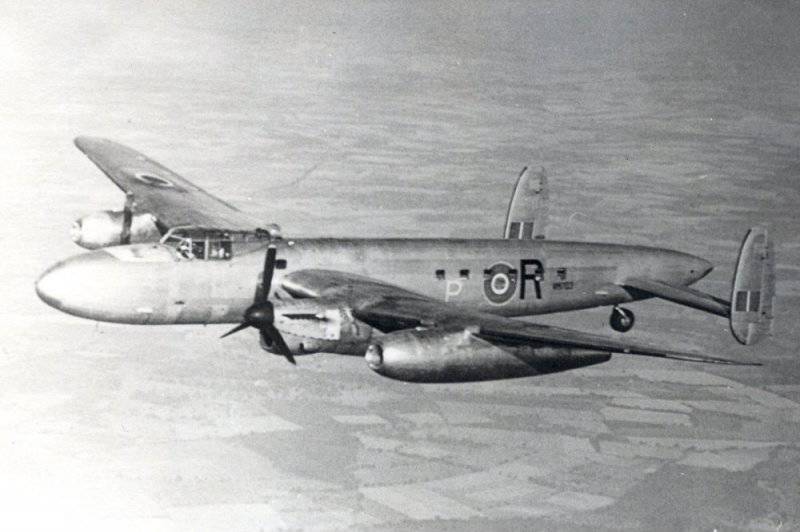
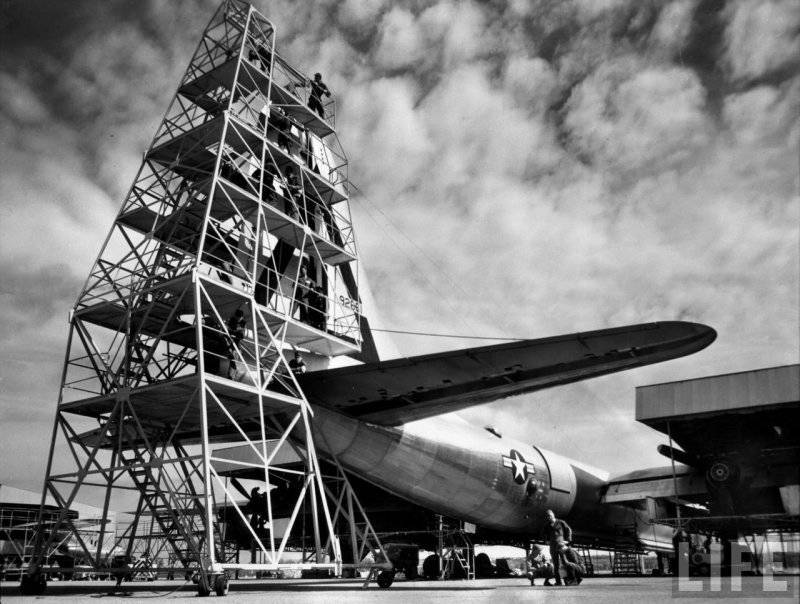
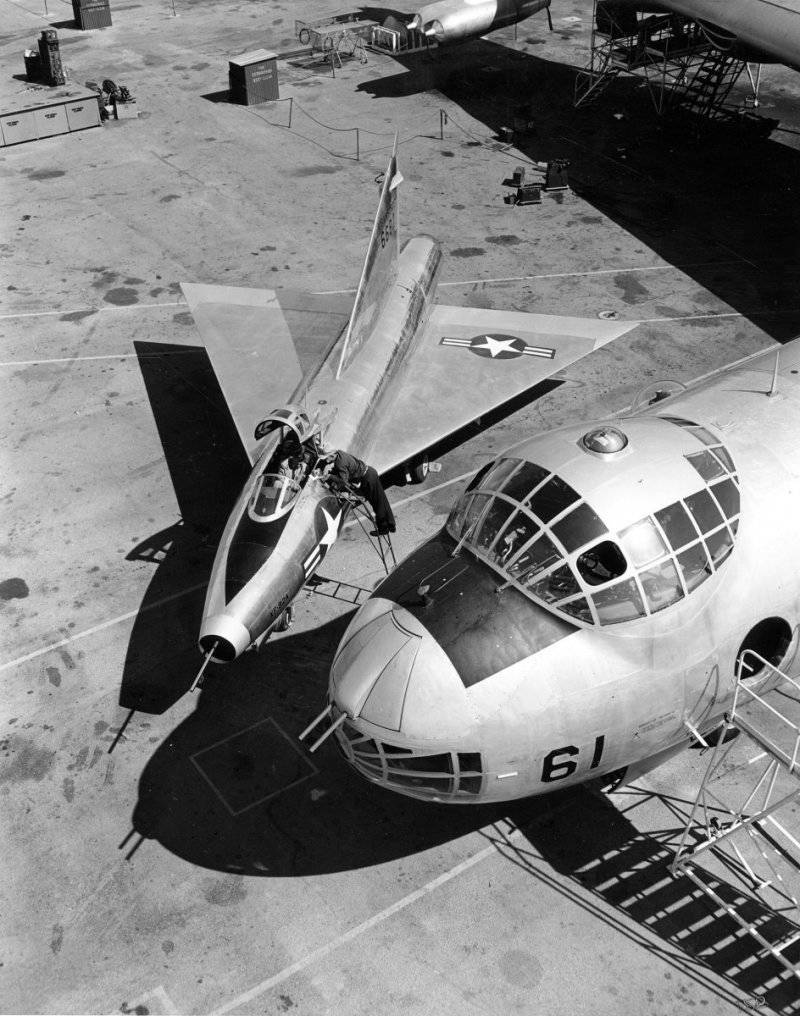
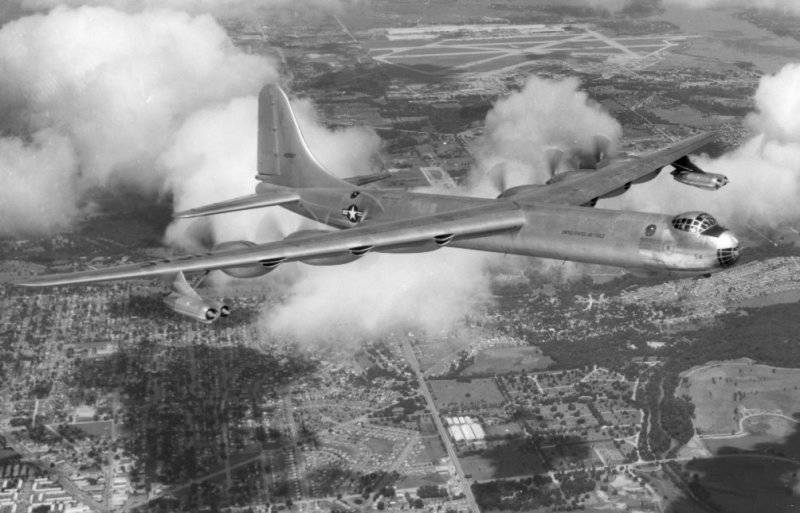
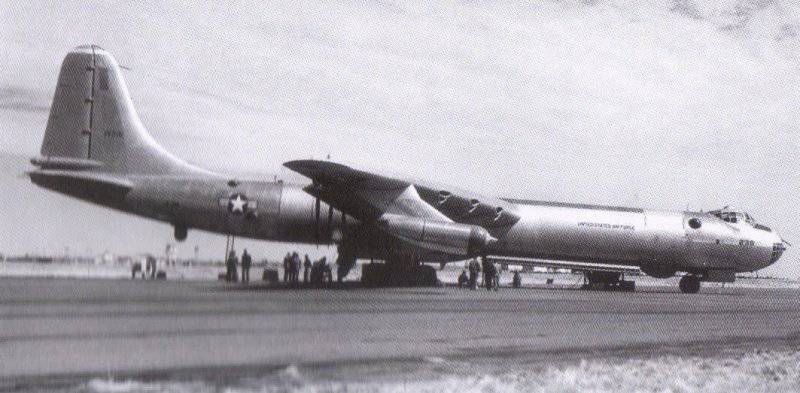
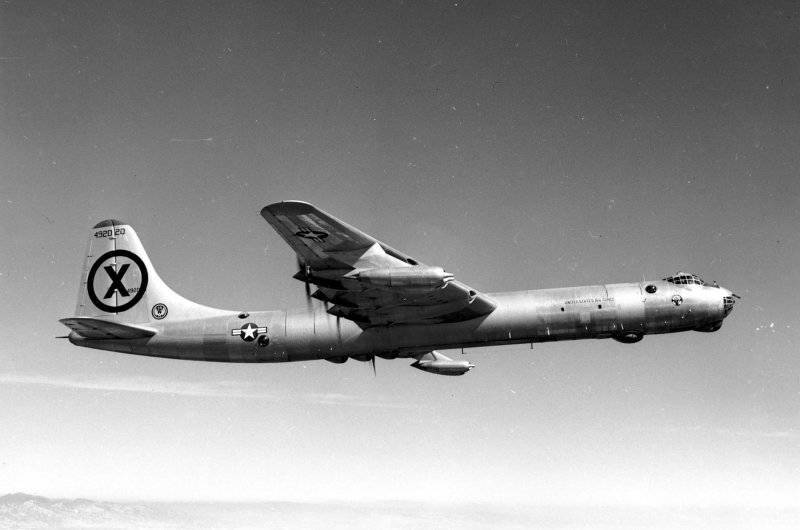
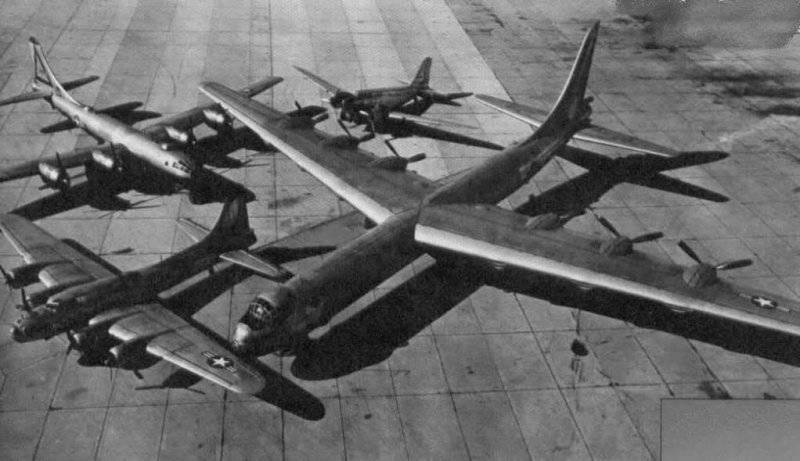
Information